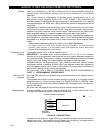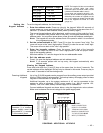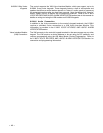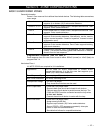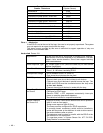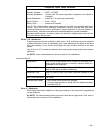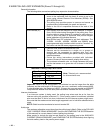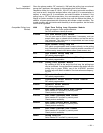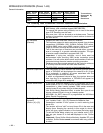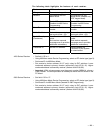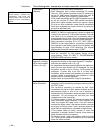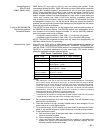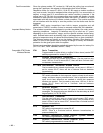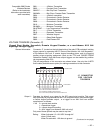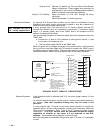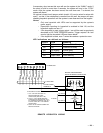
Ð 22 Ð
WIRELESS EXPANSION (Zones 1Ð63)
General Information
4281 Series 5700 Series 5881 Series 5800 Series
Receivers Transmitters Receivers Transmitters
4281H 63 + 1 RF keypad 5881H 63 + 1 RF keypad
4281M 8 5881M 16
4281L 4 5881L 8
Transmitters
Supported By
Various
Receivers
The following table summarizes wireless expansion characteristics.
Zones Supported ¥ The system supports up to 63 wireless transmitters (5700 or
5800 series), plus a wireless keypad (5827/5827BD).
¥ To expand the system using wireless, one or two of the same
type of RF Receivers can be used.
¥ Any zone from 1-63 can be used as a wireless zone. The total
number of transmitters supported by each receiver is shown in
the table above.
RF Receivers ¥ Supports the 4281 and 5881 series RF receivers.
(General) ¥ The receivers respond to status and alarm signals from wireless
transmitters (@345MHz USA; 315MHz Canada 5700 series,
345MHz 5800 series using 5882 receiver) within a nominal
range of 200 feet, and relay this information to the control.
¥ Two of the same type of receivers can provide either a greater
area of coverage, or to provide redundant protection. The type
of receiver used is identified in program field 1*32.
Important: If using two receivers, one of them must be
disconnected while enrolling 5800 series transmitter serial
numbers. You will not be able to enroll serial numbers if both are
connected during the serial number enrolling procedure.
¥ Receivers must be mounted externally to the control a minimum
of 10' away from the control and from other receivers.
¥ The 4281/5881 receivers connect to the keypad data lines.
Receiver Supervision ¥ If the connection is broken between the receiver and the control
panel, a TROUBLE will be displayed for zones 89 or 91 (if type
05 is assigned). In addition, all zones associated with the
receiver will report a trouble condition.
¥ If, within a programmed interval of time, the receiver does not
hear from
any
of its transmitters, a TROUBLE will appear for
zones 88 or 90 (if type 05 is assigned).
House Identification ¥ 5700 series receivers respond only to transmitters set to the
same house ID (01-31). This prevents system interference from
transmitters in other nearby systems. 5800 series receivers
require house ID only when using a wireless keypad.
¥ Use Sniffer Mode (described later) to make sure you do not
choose a House ID that is in use in a nearby system.
¥ 4281/5881 (for 5827) house ID is programmed via #93 Menu
Mode, Device Programming.
Sniffer Mode For ¥ To check for house IDs being used in nearby systems, enter
House ID your "Installer Code" + [#] + [2]. Remove the batteries from
(Code + [#] + [2]) transmitters installed in this system to avoid receiving their
house IDs.
¥ The receiver will now "sniff" out any House IDs in the area and
display them. Keeping the receiver in this mode for about 2
hours will give a good indication of the house IDs being used.
To exit the Sniffer Mode, simply key your installer code + OFF,
then set your house ID to one not displayed in the "Sniffer
Mode".
¥ Important: Since Sniffer Mode effectively disables RF point
reception, Sniffer Mode cannot be entered while any partition
is armed.



